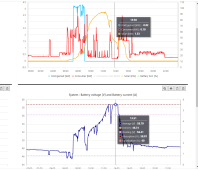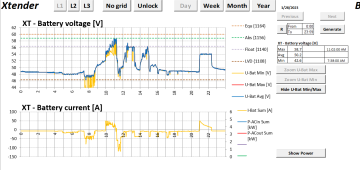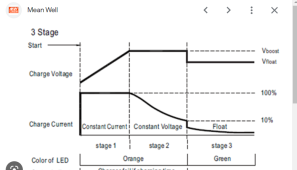You are using an out of date browser. It may not display this or other websites correctly.
You should upgrade or use an alternative browser.
You should upgrade or use an alternative browser.
batteries' behavior
- Thread starter joaa
- Start date
sunshine_eggo
Happy Breffast!
No idea.
Don't know what type of battery, capacity, and I don't see that the actual current is included on the "battery voltage and battery current" charts.
Don't know what type of battery, capacity, and I don't see that the actual current is included on the "battery voltage and battery current" charts.
its 24 batteries 2v RES 5 SopZs 860 lead acid equal to 30kwh capacityNo idea.
Don't know what type of battery, capacity, and I don't see that the actual current is included on the "battery voltage and battery current" charts.
sunshine_eggo
Happy Breffast!
And the current?
Isn't the load of the home enough to know if there isn't a graph for the current?And the current?
sunshine_eggo
Happy Breffast!
Isn't the load of the home enough to know if there isn't a graph for the current?
Yeah, but why force those you're asking for help to make additional guesses and calculations?
Ah, I remember you now.
Given the information, I don't see anything that stands out as wrong. Can you articulate your concern in another way?
sunshine_eggo
Happy Breffast!
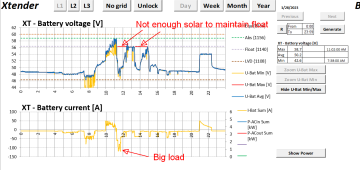
Per the other thread,

lead acid batteries
Dear all, My technician has set settings on my Deye 6000-48v inverter; could you kindly explain how he calculated the charge and discharge current? Absorption:56.7vdc Absorption duration 2 hours Float 53.52 Vdc Charge current 71 Adc Discharge current 135 Adc He once informed me that he...
Your absorption and float voltages are too low unless it's > 25°C.
PV doesn't perform well unless you have completely clear skies with no shading from sunrise to sunset.
If you're using more energy than your PV can provide in day, then you need more PV.
Ampster
Renewable Energy Hobbyist
I think the angle of the slope depends on what time frame is on the horizontal axis. I agree that if you are using more energy than your PV can provide, then you need more PV. The two important variables to look at are production and consumption. I like to view those numbers in Watthours or kWhours to eliminate voltage differences. The batteries are only an intermediary. They allow you to store production when the sun is shining and allow you to shift consumption to a time period when there is no production. There will be some loss in doing that.Did you note how the decline from v boost to v float isn't as dramatic as in my case?
Last edited:
sunshine_eggo
Happy Breffast!
I think the angle of the slope depends on what time frame is on the horizontal axis.
and loads. Significant loads at the end of absorption can instantly pull the voltage down to float.
I think the angle of the slope depends on what time frame is on the horizontal axis. I agree that if you are using more energy than your PV can provide, then you need more PV. The two important variables to look at are production and consumption. I like to view those numbers in Watthours or kWhours to eliminate voltage differences. The batteries are only an intermediary. They allow you to store production when the sun is shining and allow you to shift consumption to a time period when there is no production. There will be some loss in doing that.
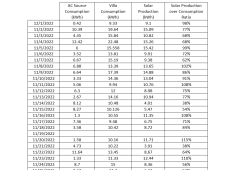
sunshine_eggo
Happy Breffast!
I don't understand how you can think this is a battery issue in any way.
You literally just posted a table full of data showing you rarely produce enough PV to offset your consumption.
Of all the data provided, you only covered 78.4% of your consumption via PV.
It's clear you're compensating with another AC source (grid? Generator?).
Are you getting the batteries fully charged?
What logic determines when you draw from AC source?
You literally just posted a table full of data showing you rarely produce enough PV to offset your consumption.
Of all the data provided, you only covered 78.4% of your consumption via PV.
It's clear you're compensating with another AC source (grid? Generator?).
Are you getting the batteries fully charged?
What logic determines when you draw from AC source?
400bird
Solar Wizard
I'm just wondering if the batteries need to be replaced or if I simply need more PV panels.
I should hope you can put it together from your own chart. Only a few days did you cover your loads with solar.
Also, lead acid is very particular about charging. My understanding is that you need to hit at least a minimum current and if you're going to start a charge to you also need to finish it, that is if you want the batteries to last.
I will undoubtedly install PV panels; I simply need to know if the batteries are nearing the end of their useful lifeI don't understand how you can think this is a battery issue in any way.
You literally just posted a table full of data showing you rarely produce enough PV to offset your consumption.
Of all the data provided, you only covered 78.4% of your consumption via PV.
It's clear you're compensating with another AC source (grid? Generator?).
Are you getting the batteries fully charged?
What logic determines when you draw from AC source?
Since the batteries were installed three years ago, I'm wondering if their life is coming to an end, and I'm not sure how to configure this. That's why I'm showing the battery voltage so you can tell me if the batteries are discharging quickly ( huge slope)
sunshine_eggo
Happy Breffast!
Since the batteries were installed three years ago, I'm wondering if their life is coming to an end, and I'm not sure how to configure this. That's why I'm showing the battery voltage so you can tell me if the batteries are discharging quickly ( huge slope)
The only way to determine if the batteries are at end of life is to do some deliberate testing with a constant load (current). This tends to make normal use impossible for a day or more.
You should be charging to 60V per the other thread. You're falling short. The only way this is okay is if you're notably above 25°C.
Lastly, voltage drops when a load is applied. When you apply a load, the voltage will drop. Period. The heavier the load, the farther the drop.
When the battery is at absorption voltage, you should measure and record the voltage of each individual 2V cell.
Similar threads
- Replies
- 4
- Views
- 265
- Replies
- 4
- Views
- 212
- Replies
- 12
- Views
- 334
- Replies
- 5
- Views
- 299
- Replies
- 19
- Views
- 1K



